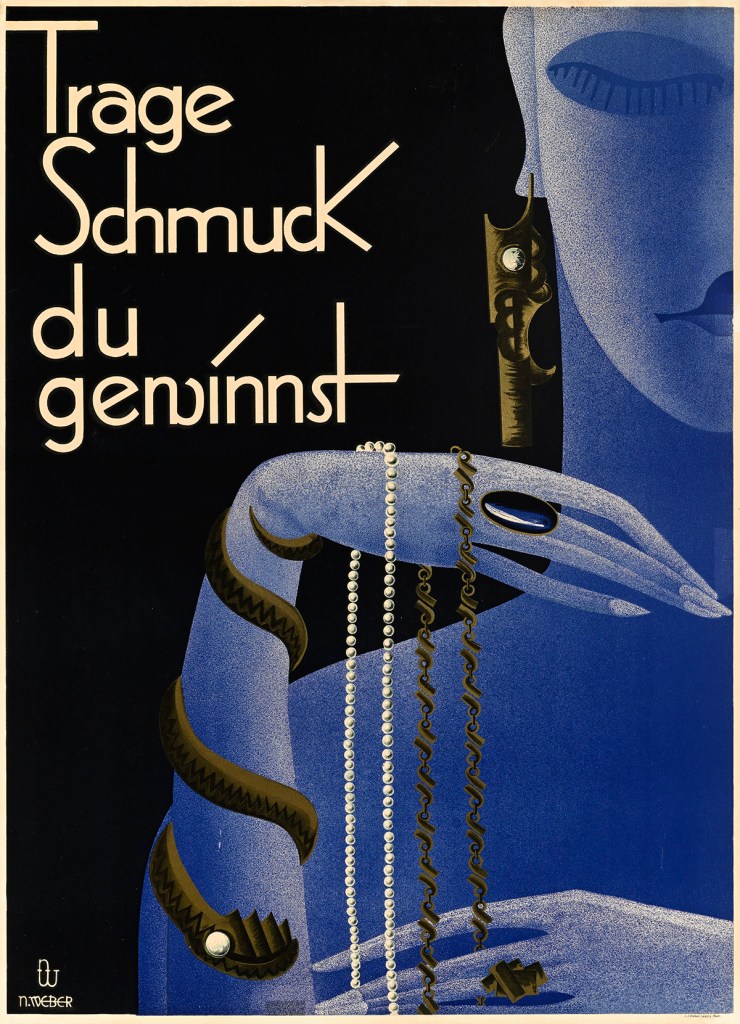This year marks the 100th anniversary of the Exposition Internationale des Arts Décoratifs et Industriels Modernes, a landmark event held in Paris that gave name to the Art Deco style. The most diverse and eternal design movement of the 20th/21st centuries, it popularized sleek geometric shapes, bold linear designs and vibrant colors.
Tomorrow, the Sarasota Art Museum opens Art Deco: The Golden Age of Illustration, on view through March 29, 2026. The exhibition of 100 posters from the 1920s and 1930s—featuring subjects ranging from automobiles, airlines and ocean liners to drinks and tobacco—offers insight into the international growth of consumpion. Initially, Art Deco’s stylized forms symbolized wealth and luxury, signaling a pivotal shift in design preferences. The curator of the exhibition, Rangsook Yoon, took some time prior to the opening to explain the unprecedented popularity of a style that was equally ubiquitous commercially as it was for promoting political ideologies.
I’m always excited to see how Art Deco and modernistic design is interpreted in today’s context. What is your rationale for the exhibition?
We are excited to be part of the worldwide centenary celebrations of Art Deco, marking a new chapter for Sarasota Art Museum as we expand our exhibition offerings beyond contemporary art to include modern art and design shows. As a six-year-old institution, Sarasota Art Museum remains nimble and responds to the needs and interests of our growing regional audiences. This expansion of our exhibition scope underlines our commitment to enriching the cultural lives of our community.
This exhibition also taps into strong local connections and promises institution-wide impact. The majority of the works are from collectors and Sarasota residents William W. and Elaine Crouse. Their Art Deco collection, which includes posters and decorative objects ranging from cocktail shakers to sculptural works, ranks among the finest in private hands. Visitors will also see furniture from The Wolfsonian-Florida International University in Miami Beach. In addition, the exhibition provides invaluable opportunities for students at Ringling College of Art and Design, especially those majoring in graphic design and illustration. We invite them to utilize the exhibition to understand the Art Deco movement and aesthetics and draw creative lessons from these timeless works.
Gert Sellheim (German-Australian, 1901–1970). Australia: Sunshine and Surf, 1936. Lithograph, 40 1/2 x 25 1/2 in. Collection of the Crouse Family. Courtesy of Poster House.
Who else makes up the intended audience?
Art Deco: The Golden Age of Illustration is geared toward a general audience with an art historical and scholarly flair. Visitors will gain meaningful insights into the period, grounded in historical facts. The exhibition is organized into nine sections, such as “Driving Desire: Automobiles and the Rise of Car Culture” and “Wired for Life: Power and Communication in the Modern Era.” They explore the cultural products that these 100 posters were created to promote and advertise. More than 100 extended labels accompany the visual works and 3D objects, highlighting their importance not only as visual masterpieces, but also as windows into the mass consumer culture in the early 20th century.
Scotti (Argentinian, 1901-1957). Mar del Plata, 1930. Collection of the Crouse Family. Courtesy of Poster House.
Why has Art Deco become such a perennial favorite in the worlds of design and art?
Art Deco’s enduring appeal lies in its uncanny ability to capture the essence of modernity, however we choose to define it. While the characteristics of the industrial and machine age have evolved over the past century, we still live within the continuation of its influence, which gives the style a sense of relevance—we might call it timelessness.
Drawing lessons from avant-garde movements like the Bauhaus, Art Deco translated these utopian ideas to democratize its ideals in real life more successfully than its predecessors, connecting with a broader audience through designs that are bold, clear and frequently deceptively simple.
Perhaps its familiarity across so many forms—architecture, functional objects and visual imagery like posters worldwide—also contributes to its lasting appeal. Its visual language communicates powerfully on its own, making it instantly engaging and universally compelling. Despite variations across countries, Art Deco maintains a distinctive identity—much like a charismatic personality whose unique flair draws you in. Its visual association with the cultural zeitgeist and glamor of the Jazz Age is another important historical factor in its lasting appeal.
Roger de Valerio (French, 1886–1951). Chrysler, 1930. Collection of the Crouse Family. Courtesy of Poster House.
Edward McKnight Kauffer (American, 1890–1954). Soaring to Success! Daily Herald – The Early Bird, 1918. Collection of the Crouse Family. Courtesy of Poster House.
Which of your gems is the most important in terms of form and execution?
To choose only one, I think it has to be Paul Colin’s poster La Revue Black Birds: Moulin Rouge (1929), which is in fact the only copy known to exist. This rare poster reflects the cultural fascination of the era, often described as “Negrophilia.” In the Roaring Twenties and 1930s, the era of Josephine Baker’s triumph as a cultural icon, bohemian Paris embraced Black American performers and writers. This revue (a combination of music, dance and sketches) was conceived and directed by white impresario Lew Leslie, who had first staged it on Broadway under the title Blackbirds of 1928. The show became the longest-running production featuring an all-Black cast, and Leslie was the first Broadway producer to present African American performers without blackface. When the revue was brought to Paris in 1929, it sold out the Moulin Rouge for three months.
Colin’s poster unmistakably echoes the racist caricatures historically used to advertise minstrel shows. However, it also marks a moment of Black visibility and success on the stage. The poster uses geometric forms and angular lines to create theatrical likenesses of its American Broadway stars: Bill “Bojangles” Robinson, Adelaide Hall and Tim Moore.
Franz Hagenauer (Austrian, 1906–1986). Romeo and Juliet, n.d. Chromed Metal, 21 x 16 3/4 in. each. Collection of the Crouse Family. Sarasota Magazine Content Studio.
Is Art Deco “art” or “decoration,” style or language?
I consider Art Deco an amalgamation of all of that, rather than one or the other. It encompasses a movement, a style, an idea and a visual language that melds art with design, pairs commercialism with fine art and integrates them into everyday life.
The Bauhaus promoted a utopian vision of art and design as a force for social improvement. Its democratic ideals held that good design should be accessible to everyone, and that art, craft and industry could be unified to enhance daily life. The school emphasized functional, affordable and well-designed objects, aiming to bridge the gap between fine art and practical living and foster a more egalitarian, modern society.
Building on these ideas, Art Deco translated them more widely and commercially, reaching a broad audience with its emphasis on practicality and functionality. Art Deco’s emphasis should lie equally on art, decoration, style, language and more.
Who, in your view, are the exemplars of the manner/method?
Art Deco: The Golden Age of Illustration includes many iconic works by trailblazing graphic designers of the early 20th century. For me, the standout is undoubtedly A. M. Cassandre. His works are quintessential exemplars, especially those created for French brands like Dubonnet and Leroy, as well as for ocean liners such as the Normandie and various railways. They combine charming visual clarity, unparalleled wit and psychologically compelling visual communication to make viewers desire the products, brands and experiences he was advertising. In doing so, Cassandre seductively captured viewers’ imagination, instilling a genuine sense of want and desire. I feel like a fully convinced consumer myself, eager to buy and experience everything his images are selling!
Paul Colin (French, 1892–1985). Leroy: Premier Opticien de Paris, 1938. Collection of the Crouse Family. Courtesy of Poster House.
The post The Daily Heller: Art Deco Takes the Edge Off Modern Design appeared first on PRINT Magazine.

